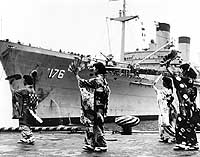
Shipborne logistics between the United States and the Korean War zone represented a huge job for the Navy, the Military Sea Transportation Service (MSTS) and the Merchant Marine. Though the aircraft of the day could fly some high-priority items across the Pacific, the overwhelming majority of personnel, equipment and supplies necessarily had to go by sea. This included nearly all combat aircraft but the largest bombers, as those were the days before wide-spread aerial refueling permitted the global deployment of tactical aircraft.
Trans-Pacific steaming distances were (and are) vast. There are some 5000 miles between San Francisco to Korea, representing about two weeks at sea at a transit speed of fifteen knots. Thus, a ship needed at least a month, and frequently much more, to carry its cargo from the U.S. to Japan or Korea, unload, and return for more. Great numbers of cargo and passenger ships were required to keep the war machine functioning. A simultanous defense build-up in Europe compounded the shipping problem.
In the early months of the Korean War, the provision of shipping was nearly as great a problem as the availability of trained men and modern equipment. However, by the fall of 1950, logistics between the U.S. and the Korean war zone had become essentially routine. More shipping capacity had been brought into service, port facilities in Korea enhanced and logistics organization upgraded. From then until the end of the conflict in mid-1953, materiel and people streamed back and forth across the Pacific, ensuring that the fighting forces in Korea received all they required to sustain the kind of war they were obliged to fight. In addition, the shipping system brought home veterans of the combat effort, plus aircraft and other equipment that needed extensive refurbishment.
This page features a special selection of images of the transportation of personnel, equipment and supplies to and from the Korean war zone.
For broader photographic coverage of Korean War trans-Pacific logistics, see:
For links to more pictures of Korean War logistic efforts,
see:
For a precis of our Korean War images, and links to more
comprehensive pictorial coverage of other aspects of that conflict,
see:
| If you want higher resolution reproductions than the Online Library's digital images, see: How to Obtain Photographic Reproductions. |
Click on the small photograph to prompt a larger view of the same image.
|
Photo #: NH 96973 First Provisional Marine Brigade Boarding USS Pickaway (APA-222) at San Diego, 11 July 1950, en route to Korea. Photographed by Sgt. Charles R. Strathman, USMC. Official U.S. Marine Corps Photograph, from the collections of the Naval Historical Center. Online Image: 112KB; 600 x 765 pixels |
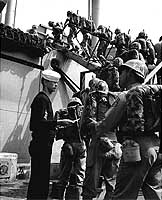 |
|
Photo #: NH 96995 USS Badoeng Strait (CVE-116) Loading Marine Corps F4U-4B "Corsair" fighters at Naval Air Station North Island, San Diego, California, for transportation to Korea, July 1950. Badoeng Strait carried planes and aircrew of Marine Air Group 33 as part of the trans-Pacific movement of the First Provisional Marine Brigade, the initial Marine Corps deployment of the Korean War. She left San Diego in mid-July and arrived at Kobe, Japan on 31 July, flying her planes off the following day. Official U.S. Navy Photograph, from the collections of the Naval Historical Center. Online Image: 99KB; 605 x 765 pixels |
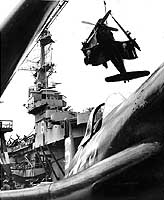 |
|
Photo #: NH 104664 USNS General M. C. Meigs (T-AP-116) "Cracks along under the Golden Gate Bridge, outward bound for the Far East," (quoted from the original caption rleased by Military Sea Transportation Service, Pacific). The photograph was taken between July 1950 and September 1953 from the south tower of the bridge. Official U.S. Navy Photograph, from the Military Sealift Command collection at the Naval Historical Center. Online Image: 62KB; 740 x 555 pixels |
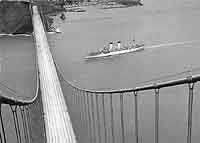 |
|
Photo #: 80-G-448046 USS Ajax (AR-6) Lieutenant Commander Kyusup Chung, Republic of Korea Navy, a passenger aboard Ajax, conducts a course in spoken Japanese for U.S. officers and men, while the repair ship was en route to Japan for her second Korean War deployment, September 1952. Japanese words are written on the blackboard in both "Romanji" and "Katakana". Note loudspeaker and basketball net mounted on the next deck up. Official U.S. Navy Photograph, now in the collections of the National Archives. Online Image: 109KB; 740 x 605 pixels Reproductions of this image may also be available through the National Archives photographic reproduction system. |
 |
|
Photo #: 80-G-441050 USS General J. C. Breckinridge (AP-176) Is greeted by Japanese Geisha as she arrives at Yokohama Army Port with Servicemen's dependents on board, 29 March 1952. Photographed by AF2 Myles E. Vallejo. Official U.S. Navy Photograph, now in the collections of the National Archives. Online Image: 105KB; 740 x 605 pixels Reproductions of this image may also be available through the National Archives photographic reproduction system. |
 |
|
Photo #: NH 97295 USS Leyte (CV-32) Loading aircraft at Yokosuka, Japan, for transportation to the United States, at the end of her Korean War combat tour. Photograph is dated 24 January 1951. Several decommissioned frigates (PF) are moored in groups across the harbor background and snow-capped Mount Fuji is visible in the left distance. Official U.S. Navy Photograph, from the collections of the Naval Historical Center. Online Image: 78KB; 740 x 605 pixels |
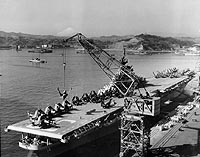 |
|
Photo #: 80-G-427104 USS General George M. Randall (AP-115) A firing squad of 34th Infantry Korean War veterans fires the traditional three volleys in salute, as the transport prepares to leave Yokohama, Japan, with the first Korean War dead to be returned to the United States. Photographed by C.K. Rose. Photo is dated 11 March 1951. Official U.S. Navy Photograph, now in the collections of the National Archives. Online Image: 88KB; 740 x 610 pixels Reproductions of this image may also be available through the National Archives photographic reproduction system. |
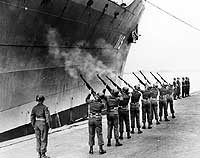 |
|
Photo #: 80-G-428657 USNS General LeRoy Eltinge (T-AP-154) Some 1500 Korean War Army veterans receive a royal sendoff as they depart Sasebo, Japan, for home, 30 April 1951. Note signs bearing the insignia of several Army divisions, including (from left): Eleventh Airborne Div., Third Infantry Div., Second Infantry Div., and First Cavalry Div. Official U.S. Navy Photograph, now in the collections of the National Archives. Online Image: 145KB; 740 x 615 pixels Reproductions of this image may also be available through the National Archives photographic reproduction system. |
 |
|
Photo #: 80-G-434458-A Staff Sergeant Phillip Korei, USMC Rejoins his wife and son, Phillip, Jr., after months of separation, at Treasure Island, California, 26 September 1951. He returned to the U.S. on the USS General William Mitchell (AP-114), under the Korean War rotation plan. Note miniaturized Marine uniform worn by Phillip, Jr. Official U.S. Navy Photograph, now in the collections of the National Archives. Online Image: 100KB; 740 x 620 pixels Reproductions of this image may also be available through the National Archives photographic reproduction system. |
 |
For broader photographic coverage of Korean War trans-Pacific logistics, see:
For links to more pictures of Korean War logistic efforts,
see:
For a precis of our Korean War images, and links to more
comprehensive pictorial coverage of other aspects of that conflict,
see:
| If you want higher resolution reproductions than the Online Library's digital images, see: How to Obtain Photographic Reproductions. |
Page made 15 August 2000
New image added 28 February 2007